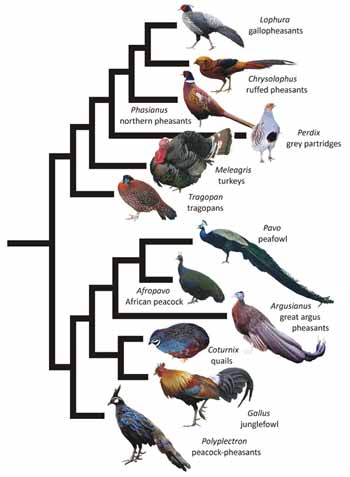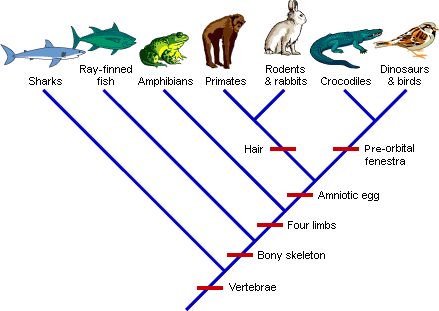Classification

 Eukarya- classified by containing membrane bound organelles
including the nucleus which includes genetic material (DNA).
Eukarya- classified by containing membrane bound organelles
including the nucleus which includes genetic material (DNA).
Animalia- classified as being multicellular and heterotrophic (rely on other organisms for food). These organisms are more commonly known as animals which surprisingly include the "little black ant!"
Chordata- classified as possessing a notochord at some point in development. A notochord is a rod that extends the length of the body to provide support for locomotion. Chordates also possess many other features such as an endoskeleton, bilateral symmetry and a complete digestive system.
Aves- classified as vertebrates with feathers which have been modified for flight and metabolic processes. They’re birds!
Galliformes- classified as “chicken-like” or a game bird; possess a chicken-like appearance and blunt wings but are very diverse in color, size and behavior.
Phasianidae: classified as “small to large, blunt-winged terrestrial birds”. This family includes grouse, turkeys, partridges, and quail. All phasianids possess small, rounded wings but are extremely diverse in habitat and reproduction.
(Animal Diversity Web 2013)
Phasianus: literally defined as typical pheasant, classified as a gamebird that possesses a large body and long tail (TheFreeDictionary 2013)
Phasianus colchius: the English meaning is common pheasant that has bright plumage and a white neck ring giving it the common name, the ring-necked pheasant! (Audioenglish 2013)
I bet you’re wondering where the pheasant fits in within the tree of life….pictured to the left is a phylogenetic tree holding Phasianus colchicus along with its most recent common ancestors. This phylogenetic tree was drawn using both morphological and molecular information. This means that the genomes of the organisms were compared along with the physical appearances of the birds. As you can see, the ring-necked pheasant shares a most recent common ancestor with gallapheasants plus ruffed pheasants. You can also see that the ring-necked pheasant is somewhat less related to grey partridges and turkeys.
The second phylogenetic tree on the right contains common organisms that everyone recognizes. This tree displays a hypothesis of the evolutionary development of different organisms. Surprisingly, birds, which contain the ring-necked pheasant, are most closely related to crocodiles. They also share an evolved characteristic of the pre-orbital fenestra which is an anterior hole in the skull to reduce weight. It is also believed that dinosaurs are the ancestors to living birds. Another trait that places the ring-necked pheasant within the birds is the development of the amniotic egg which allows pheasants to lay eggs in dry, terrestrial habits instead of aquatic areas.
Now you know where the ring-necked pheasant stands in the tree of life, but do you know where these birds originally came from? Click Habitat and Geography to find the answer!


